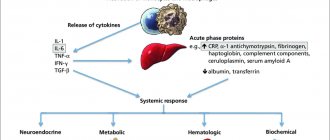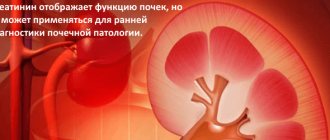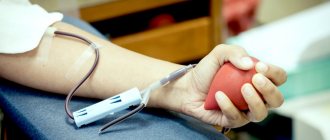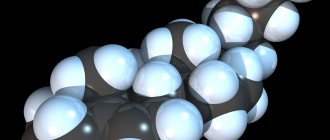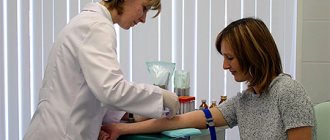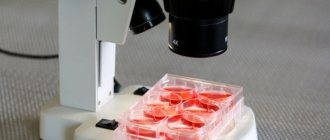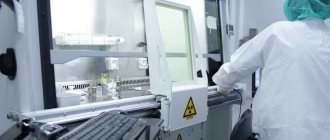Elevated lactate dehydrogenase causes
Increased rates are observed in pregnant women and with excessive physical activity.
If, as a result of the analysis, lactate dehydrogenase is elevated. The reasons for this are the development of the following conditions:
- Myocardial infarction.
- Viral liver diseases.
- Cirrhosis of the liver.
- Oncology.
- Acute pancreatitis.
- Pathological kidney diseases.
- Anemia.
- Leukemia.
- Conditions in which extensive cell breakdown occurs: shock, severe hypoxia, large-area burns.
- Extensive injuries.
- Diseases of the muscular system.
However, not only this analysis confirms the presence of pathology in the body. Further examination is necessary. By studying the activity of isoenzymes, a specialist will be able to determine the location of the disease.
Indications for analysis
A blood test for lactate dehydrogenase is a biochemical one, and is prescribed if the following diseases are suspected:
- Severe forms of anemia . Such pathological conditions lead to the death of red blood cells due to insufficient iron in the body. This leads to an increase in LDH,
- Suspicions of tumor formations . LDH biochemistry is not a means of diagnosing cancer. To do this, doctors use a tumor marker,
- Death of heart muscle tissue . The LDH compound is released into the blood during necrosis of myocardial tissue,
- All pathological conditions in which any tissue of the human body dies.
Any suspicion of necrotic changes in tissues inside the human body leads to a referral for a biochemical blood test for LDH.
What additional tests are recommended?
In addition to measuring the levels of this enzyme, additional types of blood tests may be prescribed.
These include:
- Alanine aminotransferase (ALT),
- Aspartate aminotransferase (AST),
- Total creatine kinase,
- Creatine kinase MB,
- Lactate dehydrogenase 1, 2 (LDH 1, 2 fractions),
- Total alkaline phosphatase,
- Troponin I,
- Myoglobin.
Myoglobin
Preparing for analysis
Once a patient has been scheduled for LDH testing, some preparatory measures should be taken. They are followed in order to obtain the most accurate result, since some third-party factors can affect the composition of the blood.
The actions that must be taken when preparing for LDH analysis are:
- The analysis is given on an empty stomach. Eating must be stopped at least eight hours before donating blood.
- At least one day before blood sampling , you need to stop eating fatty, highly salted, spicy or spicy foods,
- At least 7 days (!) give up alcoholic beverages,
- Strong physical activity,
- If the patient is taking medications (vitamin C), they must be stopped at least 48 hours before blood sampling. If you continuously use drugs, you need to notify your doctor about this so that he takes into account all the corrections in the test results, which will contribute to an accurate diagnosis,
- Avoid stressful situations , nervous breakdowns and anything that burdens the nervous system.
If you do not follow the measures recommended above, this may lead to inaccurate test results, as a result of which you will have to donate blood again.
Treatment of diseases and changes in LDH
If lactate dehydrogenase is elevated, treatment of the disease can gradually bring this indicator back to normal.
- In acute renal exacerbations, LDH is elevated, but in the chronic course of the disease it remains normal. Increases after hemodialysis.
- In liver cirrhosis and chronic hepatitis, LDH levels are normal; during exacerbation of the disease, the values increase.
- In case of anemia, LDH is used for differential diagnosis.
- During a heart attack, LDH rises, and after 10-14 days it returns to normal. Monitoring this enzyme allows the doctor to analyze the progress of treatment.
If lactate dehydrogenase is elevated at the onset of the disease, then with successful treatment of anemia, leukemia, and tumor diseases, LDH activity decreases.
Here is a not entirely simple analysis that most of us are not even aware of. And he, it turns out, can tell the attending physician a lot.
Lactate dehydrogenase (LDH) in the blood is a laboratory test with low specificity. However, its deviation from the norm is a sufficient condition for conducting a comprehensive examination of the patient. It is necessary for the primary diagnosis of pathologies in the heart, lungs, kidneys, various oncological pathologies and destruction of muscle tissue in humans.
Indicators of biochemical blood analysis in oncology
Malignant diseases change not only the indicators of a general blood test, but also a biochemical study.
The transcript of a blood test for pancreatic cancer indicates a change in glucose levels. Glucose is the main indicator of carbohydrate metabolism in the body. The pancreatic hormone insulin is responsible for its production.
In case of malignant disease of the biliary tract, a biochemical blood test determines an increase in the content of the bile pigment bilirubin . This is due to the development of blockage of the bile ducts.
Malignant liver tumors are manifested by an increase in the activity of the enzymes aspartate aminotransferase ( AST ), alanine aminotransferase ( ALT ) and lactate dehydrogenase ( LDH ).
Tumor processes in bone tissue are manifested in the results of blood biochemistry by an increase in the concentration of the enzyme alkaline phosphatase (a participant in the breakdown of phosphoric acid in the body).
In addition, depending on the type of tumor process and its localization, many other indicators of biochemical research change.
The values of the following blood test indicators in oncology increase:
- urea is the end product of protein metabolism;
- uric acid is the end product of the metabolism of purines (compounds containing nitrogen);
- Gamma globulin is a blood plasma protein.
A biochemical blood test for malignant pathologies usually shows a decrease in the blood levels of albumin (one of the main blood proteins) and fibrinogen (a blood plasma protein that takes part in blood clotting).
Only an experienced doctor can make a competent interpretation of any blood test. Under no circumstances should the patient independently interpret test results. Changes in blood test parameters can be a symptom not only of cancer, but also of many other, less severe pathologies.
source
LDH increased
Found (44 posts)
03-Ambulance March 14, 2008 / Dmitry
... hematology department with low hemoglobin (70), increased
bilirubin (88, free -82), Er... January, blood for bilirubin (moderately
increased
25-35) and hemoglobin (normal), took... 26.3, alat- 13.9, GGPT- 16.5,
LDH
- 317, Alkaline phosphatase - 792. 26. ... open
hematologist March 14, 2008 / Dmitry
... hematology department with low hemoglobin (70), increased
bilirubin (88, free -82), Er... January, blood for bilirubin (moderately
increased
25-35) and hemoglobin (normal), took... 26.3, alat- 13.9, GGPT- 16.5,
LDH
- 317, Alkaline phosphatase - 792. 26. ... open
diabetes May 10, 2007 / Vladimir...
...weakness, fatigue. Sugar is within normal limits. (compensated). I passed a biochemical blood test and a general blood test. Promoted
3 times bilirubin and
LDH
, high ROE. Doctors suspect I have jaundice (as a child I ... open
cardiologist March 15, 2007 / Irina
… 01, ASAT 57. 00, LDG
769, HBDH 354.3, LDL 4.40, Glucose 6.74. The hemoglobin level is also
increased
(15.9), ESR 36 MM/... ?
What do the results of the analysis mean, especially the indicators of AST, LDH
, HBDH (they are all significantly higher than normal)? Thank you. open
hematologist June 22, 2005 / Ekaterina...
Hello. My son is 3 years old. 3 months ago we were diagnosed with Diamond-Blackfan aplastic anemia. Now he is taking methylprednisolone and his hemoglobin has increased... open
December 9, 2006 / Marina
..., urea, creatinine, total and direct bilirubin, calcium, glucose, AlaT and AsaT, LDH
, alkaline phosphatase, amylase, ASLO, RF, CRP.
was increased
5.04 mmol/l and iron 23 mmol/l. The note says...
oncologist September 13, 2005 / Yanina
...temporal bone. In the color flow mode, blood flow will not be reliably determined. In an. blood - fyrretin is reduced 6.5 LDH
increased 666, AFP
increased
14, 88 NSE 28, 87 Doctors say that there is a 95% guarantee that it is benign ... open
therapist August 25, 2005 / Julia
... everyone is also sweating a lot. Took tests: blood (only increased iosinophils (EO) 8.5 Biochemical blood test (AlaT) 49. 1 increased
,
LDH
(Lactate dehydrogenase) 626, 6 ultrasound br. cavities + kidneys are almost all in … open
cardiologist May 13, 2005 / Jim
Started taking Locrene. My blood pressure seems to be lower, but I feel noticeable weakness. Heart rate is below 60 (reaches 52). This is fine? Thank you! open
May 13, 2005 / Zholudev Alexander Arsenievich
... prurigo. Other: allergic reactions, increased LDH
, liver enzymes (AST, ALT), acidosis, hypercholesterolemia, ... the least negative inotropic effect.
Elderly patients have an increased
risk of developing hypothermia, mental disorders, ...
neurologist November 3, 2004 / Galina Mikhailov...
... 35%, monocytes 7%, neutrophils 58%, CPK 25 u/l, LDH
176E/l, cholesterol 4.5 mmol/l, lipoproteins 5.6 g/l.
sugar 5.4 mmol/l, ... brain readiness. Doppler ultrasound of the vessels of the neck and head: increased
vascular tone. Asymmetry of blood flow velocity according to average ... open
veterinarian June 7, 2004 / Irina
Hello doctor! We took a biochemical blood test (dog, 11 years old, cannot stand on its hind legs). Total bilirubin 7.4 µmol/l; direct bilirubin 1.2 µmol/l; AST 38 units/l;… open
June 7, 2004 / Dubova A.V.
... with metastases of any tumor to the liver. But bilirubin is increased
insignificantly, also ALT and AST are within normal limits, which puts ... the process of necrosis is underway, cells are destroyed, as evidenced by an increase in
LDH
and alkaline phosphatase. Regarding which organ is suffering - according to...
Research procedure
To conduct the study, the patient’s venous blood is required, so the material is taken from the vein in the standard way by squeezing the middle part of the shoulder with a tourniquet or a special belt. A doctor's referral is required for blood collection and testing in regular clinics, but in private clinics you can get tested without a special coupon.
Blood serum is used to determine the enzyme concentration. Since LDH is not a specific indicator, no special preparation is required for its implementation, however, in order to exclude the possibility of obtaining false results, it is advisable to carry out very simple preparations first.
It is important to remember that only real indicators are valuable for diagnosis, and they depend not only on the work of laboratory technicians and compliance with the rules of the study, but also on the patient himself and his behavior.
Recommendations for obtaining reliable analysis results:
Blood should be donated on an empty stomach, and at least 8 hours should pass after dinner and before blood collection.
You do not need to follow a special diet before the procedure, but in the morning, before visiting the clinic, you should not eat anything, since in this case the collected blood will clot and the examination will be impossible. It is recommended to limit the consumption of protein and fatty foods the day before the procedure, since a high content of proteins and fat in the body will lead to cloudiness of the blood serum and its coagulation.
It is important to stop drinking alcohol 2–3 days before the procedure, since in this case all blood parameters will be changed, and the test result will have no value for diagnosis. You should also stop smoking before taking blood.
After smoking the last cigarette and the procedure, at least 2 hours should pass.
The day before donating blood, you should not take medications, as this can significantly distort the results of the study. It is also important to refrain from physical activity the day before the procedure, as this can also distort the results.
LDH blood test results should always be interpreted only by a qualified doctor.
It is important to remember that it is impossible to assert the presence of certain diseases solely based on the results of studying the concentration of LDH.
To make a diagnosis, the results of the study and other indicators, as well as other points of diagnostic value, must be taken into account.
Causes and consequences of increased LDH
The reasons why lactate dehydrogenase is elevated are varied.
Diseases in which LDH increases include:
myocardial infarction;
- hepatitis;
- jaundice;
- liver pathologies (cirrhosis);
- blood diseases;
- leukemia;
- wasting of muscle fibers;
- kidney diseases;
- acute pancreatitis;
- cancer;
- some medications;
- burns.
An increase in LDH can occur as a result of acute coronary insufficiency, as well as with other heart diseases. In addition to heart disease, some liver diseases affect LDH levels. The reasons for the increase in this enzyme in children are allowed only in infancy. Each organ has its own isoenzyme of lactate dehydrogenase, so determining which disease caused its increase is not difficult.
An analysis to determine the level of LDH is carried out:
- To determine how affected the patient's tissues are.
- To find out the cause of pain in the chest area.
- In order to find the cause of the destruction of red blood cells.
- To monitor the course of cancer.
- To conduct an examination of the liver and kidneys.
- After receiving serious muscle injuries.
The obtained material for research is stored for no more than 48 hours, the temperature should be from 18 to 25 ° C. If the sample is placed in the cold or frozen, the LDH concentration will begin to rapidly decrease, and the result will be false.
Indications for the study
Ldh in a biochemical blood test increases against the background of numerous provoking factors.
Studies are prescribed to patients in the following situations:
- chronic or acute pathological processes that are accompanied by cell damage;
- severe pain in the chest area, which often occurs with a heart attack or angina pectoris;
- monitoring the development of chronic diseases;
- comprehensive examination of a person;
- monitoring the development of cancer tumors;
- inflammatory and degenerative changes in the kidneys;
- damage to the lymph nodes;
- inflammatory process in the lung area;
- damage to the spleen;
- suspicion of pancreatitis.
Muscle inflammation and problems with hematopoiesis are also indications for biochemical analysis.
The importance of the enzyme in the body
LDH plays an important role in the functioning of the body. It is involved in chemical reactions such as the oxidation of glucose and the formation of lactic acid. LDH helps convert glucose into energy, which is necessary for the functioning of body cells. A similar reaction occurs in the presence of oxygen. As a result, carbon dioxide, energy and water molecules are released. With insufficient oxygen content, energy production decreases several tens of times and lactic acid accumulates in tissues. LDH is also needed to convert accumulated lactic acid back into glucose through a chemical reaction. A distinctive feature of LDH is that it is not able to accumulate in the body. Therefore, it is quickly destroyed and eliminated naturally from the body.
Watch a video about this indicator
Basic concepts and functions of LDH
LDH (lactate dehydrogenase) is an oxidoreductase enzyme that accelerates the reaction of lactic acid formation during glycolysis (glucose oxidation). Like most catalysts, lactate dehydrogenase does not accumulate in cells, but is excreted from the body in an amount equivalent to that formed.
The highest concentration of the enzyme is observed in the parenchyma of the liver and kidneys, in the tissues of the muscular system and heart. Each localization area has its own isoenzyme (a type of LDH). Lactate dehydrogenase is found in small amounts in red blood cells (erythrocytes).
An increase in the level of the enzyme in the blood occurs during the destruction of LDH-containing cells. By assessing the type of elevated isoenzyme during biochemistry, the location of the damage is determined, that is, the organ whose cells have undergone destruction. The enzyme isoforms are numbered 1 to 5, depending on their location:
| Isoenzyme number | Location | Percentage concentration in blood |
| № 1 | muscle layer of the heart (myocardium), brain tissue | 17–27 |
| № 2 | blood cells (platelet and erythrocyte), renal parenchyma | 27–37 |
| № 3 | lungs, spleen, thyroid gland, adrenal glands, lymphocytes, pancreas | 18–25 |
| № 4 | granular leukocytes, placenta, spleen, adrenal glands, male reproductive cells, lungs, thyroid and pancreas | 3–8 |
| № 5 | hepatocytes (liver cells), bone tissue | up to 5 |
Increased activity of one or another type of lactate dehydrogenase is a marker of the destructive transformation of the tissue of the organs in which it is contained. In a standard biochemical analysis, the form usually indicates the total LDH indicator.
If necessary, an extended study is carried out, assessing each individual isoform of the enzyme (Sevel-Tovarek test, urea inactivation and thermal inhibition methods). In the blood of a healthy person, LDH is static and has certain reference values.
Important! The changed concentration of lactate dehydrogenase does not diagnose a specific disease. The obtained values are compared with other indicators of biochemical analysis. Unsatisfactory results are grounds for additional examination of a particular system or organ.
Norm of LDH in the blood
Any interpretation of the results should be carried out exclusively by a specialist. Due to the low specificity of the criterion under consideration, its isolated use for the final diagnosis of the disease is prohibited. Indicators of normal LDH concentrations in adults and children in the blood are shown in the table.
| Floor | Age | Normal values, U/l |
| Both | 0-1 year | Up to 451 |
| 1-3 years | Up to 344 | |
| 3-6 years | Up to 314 | |
| 6-12 years | Up to 332 | |
| 12-18 years old | Up to 271 | |
| Women | 18 and older | 130 — 215 |
| Men | 130 — 230 |
It should be noted that normal LDH levels are higher in men than in women. Deviation from the reference (normal) values to a greater or lesser extent indicates the development of a pathological process.
The value of LDH isoenzyme indicators
The activity of isoenzymes is determined by the degree of inactivation by urea. It has been established that the level of inhibition of the enzymatic activity of human serum by urea ranges from 26 to 36%. This indicator is considered as a standard value for comparing the inhibitory properties of the five isoenzyme fractions.
| Isoenzyme | Inactivation level of total urea activity, % |
| LDH-1 | 20-30 |
| LDG-2 | 25-40 |
| LDG-3 | 15-25 |
| LDG-4 | 8-15 |
| LDG-5 | 8-12 |
The table shows that each fraction has its own level of inhibition. Based on the known data on the priority organ of synthesis of each isoenzyme, and the obtained test results, it is possible with a high degree of probability to determine the organ in which the disease develops.
LDH in the blood, what is it?
Laboratory blood testing for LDH is an additional diagnostic method. The analysis is not the main one for diagnosing diseases, and is used to confirm or refute diagnosed individual diseases.
The information content of the analysis makes it possible to determine the effectiveness of the applied courses of therapy, track the progression of the disease and determine its stage.
The concentration of LDH in the human body consists of five isoenzyme fractions. They are classified based on cell structure and location in different organs of the human body.
It is with the help of this classification that doctors quickly determine in which organ tissue deformation occurs, which greatly simplifies the diagnosis of pathological conditions.
These isoenzymes are presented in the following fractions:
- LDH-1. The first fraction is also referred to as the HHNN tetramer and is localized, predominantly in the myocardium and brain. The indicator of the first fraction increases significantly with deformation of cardiac muscle tissue,
- LDH-2. The highest concentration of this enzyme is recorded in liver tissues and biological material,
- LDH-3. These isoforms are concentrated in the thyroid gland, pulmonary, renal and pancreatic tissues, as well as in all smooth muscle tissues of the body,
- LDH-4 . It is located, for the most part, in the same organs as the third isoenzyme, as well as in the liver tissues, placenta and male reproductive system,
An active increase in the three above fractions occurs in pathological conditions in which platelets die in large numbers. One of the most dangerous pathological conditions leading to massive platelet death is thrombosis of the pulmonary trunk.
- LDH-5, its characteristic is the source of the enzyme, which lies in the liver tissues, skeletal muscles, placenta and male reproductive system. The enzyme increases significantly during the acute stages of viral hepatitis.
The distribution of different types of lactate dehydrogenase occurs depending on the types of tissues in which they accumulate. This means that different quantitative indicators of the fraction are recorded in different parts of the body.
The results are shown in the table below.
Fraction Quantitative indicator in serum % (relative units)
| LDH-1 | 17 – 27% (0,17 – 0,27) |
| LDG-2 | 27 – 37% (0,27 – 0,37) |
| LDG-3 | 18 – 25% (0,18 – 0,25) |
| LDG-4 | 3 – 8% (0,03 – 0,08) |
| LDG-5 | 0 – 5% (0,00 – 0,05) |
Reasons for the increase
Elevated LDH levels can be caused by various diseases:
- stroke;
- some types of anemia (pernicious and hemolytic)
- kidney and liver diseases;
- muscular dystrophy;
- pancreatitis;
- Infectious mononucleosis;
- some forms of cancer.
The concentration of the enzyme increases after the administration of anesthetics and aspirin, as well as after intense physical exercise. Normal and decreased LDH levels are not pathological. A factor that reduces the indicator is the consumption of a large dose of ascorbic acid (vitamin C).
The reasons that lactate dehydrogenase is elevated are varied: HIV infection, sepsis, acute kidney disease, infarction of the intestines and lungs, bone fractures, rash on the body.
LDH is low when transudate accumulates in body cavities, such as the abdomen, usually caused by congestive heart failure or cirrhosis.
Reasons for increased LDH in a biochemical blood test
The criterion under consideration may deviate from normal values in a number of different diseases. The reasons for the increase in lactate dehydrogenase concentration may be:
- myocardial infarction, accompanied by ischemic necrosis of the middle layer of muscle tissue of the heart;
- blockage of a pulmonary artery with a blood clot or pulmonary infarction;
- blood pathologies, which are characterized by the destruction of red blood cells (various types of anemia, hemolysis, severe intoxication);
- malignant tumors affecting various organs and tissues, often accompanied by metastasis;
- disturbances in liver function due to chronic and acute hepatitis, Gospel disease or alcohol intoxication;
- kidney pathologies (glomerular nephritis, pyelonephritis);
- muscle tissue atrophy or injury;
- open and closed fractures;
- congestive heart or coronary failure;
- inflammation of heart muscle tissue;
- mononucleosis, viral etiology;
- acute attack of pancreatitis;
- seizures;
- alcoholic delirium (mental abnormalities due to sudden withdrawal of alcohol);
- burn disease;
- premature placental abruption;
- hyperfunction of the thyroid gland.
When identifying the causes of increased LDH in women and men, it is necessary to exclude the influence of factors that can lead to unreliable results:
- improper blood sampling, resulting in the destruction of red blood cells in the test tube (hemolysis);
- neglect of the rules of preparation for the delivery of biomaterial: physical and emotional stress, smoking, alcohol, poor diet;
- the use of treatment methods accompanied by electrical stimulation of the patient a week before the analysis;
- excess platelets in the blood;
- taking medications that activate the enzyme system.
LDH and cardiac muscle necrosis
The study of lactate dehydrogenase has a special diagnostic value for diseases and damage to the heart muscle, therefore it is considered practically the main test in determining myocardial infarction, especially in the first days after the onset of such a situation.
A heart attack leads to the onset of a necrotic process of the heart muscle, which is a very dangerous condition, and as a result of the analysis, an increase in the level of LDH is observed, mainly the first and second fractions, that is, LDH-1 and partly LDH-2.
The maximum level of LDH in the patient’s blood after a myocardial infarction is observed after about a day, but usually persists for about 10 days. The degree of activity (the level of increase in the indicator) always depends on the area of the existing damage to the heart muscle; the larger it is, the stronger the increase in level will be.
The initial diagnosis of a heart attack is carried out using special laboratory tests, thanks to which it is possible to determine the level of creatine kinase, as well as its MB fractions. It makes sense to study the concentration of LDH only one day after the onset of a painful attack, and such a test is carried out to confirm the diagnosis of a heart attack. If it is present, the concentration of LDH enzymes can be exceeded several times, on average up to 10. In this case, a special activity of the fraction of this enzyme LDH-1 is observed, which is important for determining the acute degree of infarction.
Features of changes in general blood test indicators in oncology
It is impossible to say unequivocally what a blood test will be like for malignant diseases.
It depends on what type of tumor develops; in addition, its location and the nature of the disease are considered. The individual characteristics of each person’s body are also important. But it is still possible to identify some general distinctive features of the results of a blood test that will help an experienced doctor suspect the development of a malignant process.
Leukocytes
According to the interpretation of the blood test, in oncology the qualitative composition and quantitative value of leukocytes changes . Leukocytes are white blood cells that take part in the body’s immune defense against viral, bacterial, and parasitic infections. In a clinical blood test, cancer usually shows a significant increase in the number of white blood cells. A characteristic feature of the development of a malignant process is an increase in the level of leukocytes in the blood due to their young forms. The content of leukocytes increases most significantly in leukemia - malignant diseases of the hematopoietic system. Depending on the type of leukemia, a blood test may show lymphoblasts (precursors of lymphocytes) and myeloblasts (precursors of neutrophils).
In most cases, a general blood test for oncology determines a high ESR value - erythrocyte sedimentation rate. This indicator is an indirect characteristic of the content of blood plasma proteins. The doctor should be alert to the fact that the use of antibacterial or anti-inflammatory treatment does not lead to a decrease in the value of this blood indicator.
Hemoglobin
Another important blood indicator, a decrease in the value of which may indicate the development of a malignant process, is hemoglobin. Hemoglobin is a special protein found in red blood cells that is responsible for transporting oxygen from the lungs to organs and tissues, and carbon dioxide back. The doctor should be alerted to a decrease in hemoglobin in the blood if the patient does not have blood loss (during major operations, injuries, heavy menstruation). It is important that the person eats normally and leads a normal lifestyle.
The most significant and rapid decrease in hemoglobin occurs with the development of intestinal and stomach cancer. In some types of leukemia and liver cancer, in addition to a decrease in ESR, a decrease in the number of platelets is observed, and the blood clotting rate increases. A blood test for colon cancer determines anemia due to hidden bleeding. In this case, this is an early symptom of a malignant tumor. With a metastatic tumor, a decrease in hemoglobin in the blood (anemia) often develops as a result of secondary damage to the bone marrow (hematopoietic organ).
Normal levels of LDH in the blood of women and men
If a person is healthy, then the accumulation of LDH in his body does not occur, since the enzyme is neutralized through natural biological processes or simply excreted from the body. But an increase in the concentration of this enzyme leads to the appearance of various diseases and pathologies, the development of which begins to disintegrate cells.
Doctors have established certain limits of values that allow them to judge whether blood lactate is normal or whether there are any deviations. The norms, as a rule, depend on the person’s age, since as the body matures and develops, the concentration of LDH changes naturally, gradually decreasing.
The table shows the norm of LDH in children:
| Age | Enzyme concentration in µkat/l |
| Newborns in the first day of life | Up to 22.1 |
| From 2nd to 5th day | Up to 28.9 |
| From 6 days to 6 months | Up to 16.3 |
| From 6 to 12 months | Up to 18.3 |
| From 1 year to 3 years | Up to 14.2 |
Table of the norm of lactate dehydrogenase in the blood depending on gender:
| Age | Enzyme concentration in µkat/l | |
| Boys and men | Girls and women | |
| From 7 to 12 years old | Up to 14.2 | Up to 9.67 |
| From 13 and older | Up to 11.4 | Up to 7.27 |
Of course, standards will vary from laboratory to laboratory, as will the unit of measurement for enzyme concentration, which depends on the research equipment.
Some laboratories express the LDH value in units/liter, others in µmol per deciliter. Therefore, you should ask the laboratory for a printout of the established standards for an adequate assessment of the results of the study.
Decoding the analysis results
Norm
Most often, total lactate dehydrogenase is determined in the blood without dividing it into isoforms. Total blood lactate dehydrogenase has its own reference values in different age groups (Table 1).
Table 1. LDH norm in different age groups.
| Group | Norm |
| Children under 1 year | Up to 450 U/l |
| From 1 year to 3 years | Up to 340 U/l |
| From 3 to 6 years | Up to 315 U/l |
| From 6 to 12 years | Up to 330 U/l |
| From 12 to 17 years | Up to 289 U/l |
| Adult men | 135 – 225 U/l |
| Adult women | 134 – 214 U/l |
As can be seen from Table 1, the measurement units for total lactate dehydrogenase activity are units per liter.
If necessary, individual isoenzymes can be determined to clarify the localization of the pathological process.
High LDH numbers
Detection of total lactate dehydrogenase activity above normal indicates the presence of pathological conditions.
These include:
- heart pathology (myocardial infarction);
- hemolysis of the blood, in which the level of the enzyme in the blood increases due to its release from destroyed red blood cells;
- liver disorders (hepatitis, cirrhosis);
- disruption of skeletal muscle function (atrophy, dystrophy);
- hypofunction of the thyroid gland;
- burns;
- premature placental abruption, etc.
However, do not panic if you detect high enzyme activity in the blood. Many different factors can lead to increased results, for example:
- hemodialysis;
- high-intensity exercise;
- improper blood sampling leading to hemolysis;
- some medications (Aspirin, Methotrexate, Verapamil, antifungals and others).
Is below normal also bad?
Detection of enzyme activity below normal is quite rare. And the cause of low activity may be medications, such as:
- vitamin C;
- Metronidazole;
- anticonvulsants;
- Enalapril;
- Cefotaxime and others.
An increased amount of substances that inhibit the action of the enzyme also leads to a decrease in lactate dehydrogenase activity. These substances include urea, the end product of metabolic transformations of proteins.
Normal LDH in children
Let's look at the standard indicators of LDH levels in childhood:
- from 1 to 4 days of life -
- from 4 to 10 days of life -
- in children under two years of age -
- in children from two to twelve years old -
In medicine, such a biochemical analysis is usually called a UV test. This method should be prescribed for each such patient. A prerequisite is not only a brief transcript of the results, but also a detailed description of each of the indicators.
Nowadays, you can already get the results in your hands in a couple of days, since the equipment is improving and improving every year, you don’t need to worry about the quality. It very rarely happens that the result of a test turns out to be false. But in this situation, further diagnosis and treatment will not give the expected results. The tests will have to be carried out again to verify the falsity/truth of the previous test.
The level of lactate dehydrogenase differs only according to age; gender in this case does not play any role. For adults, a single norm is established, and for children it is calculated by day, especially after birth.
Highly qualified specialists are involved in diagnosing children, because mistakes cannot be made here.
Explanation of lactate dehydrogenase tests
As mentioned above, LDG is found in all cells of the body of children and adults. The main source of the LDH enzyme in the blood is destroyed connective tissue cells of organs. The LDH molecule consists of 4 subunits. This enzyme is present in human blood in five isoforms:
- LDH1 – HHHH – myocardium and erythrocytes;
- LDH2 – HHHM – lymph nodes, spleen;
- LDH3 – HHMM – lungs;
- LDH4 – HMMM – skeletal muscles, endocrine system organs, kidneys and placenta during pregnancy;
- LDH5 – MMMM – skeletal muscles and liver.
The forms of the enzyme also differ in their mobility in the blood plasma, the first one moves the fastest, and the 5th one is the slowest. Biochemistry captures LDH after the destruction of cells in the affected organ. If the internal organs are healthy, no increase in this indicator is noted. The LDH level differs in the blood of women and men. There are also differences in age categories: newborns 220-600, children over 1 year – 115-300, women 125-210, men 125-225.
As can be seen from the normal indicators, children have a high concentration of the enzyme LDH in the blood. This condition persists until adolescence, then the indicators gradually decrease and become equal to adult standards.
A high level of LDH in the blood appears 10-12 hours before an attack. The causes include liver diseases: acute liver failure, toxic solvent poisoning, viral hepatitis, infectious type mononucleosis, as well as hepatocarcinoma, cirrhosis, blood diseases: anemia, vitamin B12 deficiency, leukemia, lymphoma, inflammation of muscle tissue - myositis and polymyoside, as well as mechanical damage to muscles. Increased rates are observed in tumors, shock, pneumonia, pulmonary embolism, venous thrombosis, renal failure and infarction of this organ, acute pancreatitis, HIV, sepsis.
The reasons for the increase in LDH can have disastrous consequences and indicate inflammation of the membranes of the brain - encephalitis. In the process of blood testing, LDH levels may be increased during pregnancy, consumption of alcoholic beverages, and caffeine.
LDH can be lowered with successful treatment of tumor neoplasms, hemolytic anemia, leukemia, and lymphomas. The reasons for a low LDH level in a child and an adult are observed after a large intake of vitamin C. A decrease in levels is quite rare and generally does not pose a threat to the life and health of patients; on the contrary, they indicate the excellent condition of the internal organs.
The test results are not considered as an accurate diagnosis of a specific disease; they must be compared, for example, with liver tests and instrumental studies. Only on the basis of a comprehensive study can the causes of fluctuations in LDH levels be determined and a diagnosis made.
All about reduced lactate dehydrogenase
Lactate dehydrogenase or LDH plays an important role in the life of the body and measuring its level is necessary for diagnosing many diseases.
This enzyme is found in cells and tissues of the entire body. Therefore, by its content in the blood it is impossible to accurately identify the disease, but only to suspect a pathological process.
Cases where lactate dehydrogenase is low are rare and require additional research.
LDH is found in almost all cells and tissues of the human body and is involved in important chemical reactions. The enzyme plays an important role in the process of glucose oxidation with the release of energy to maintain cell life.
This reaction can occur either in the presence of oxygen or without it. The result is carbon dioxide, water molecules and energy. LDH is also directly involved in the synthesis of lactic acid. When there is insufficient oxygen in the body, the level of lactic acid increases sharply.
In this case, LDH promotes its conversion to pyruvic acid.
LDH is not able to accumulate in the human body.
It breaks down very quickly and is eliminated naturally .
Watch a video about this enzyme
How is the analysis carried out?
To identify low or high levels of the enzyme, patients are prescribed a biochemical blood test. Venous blood is used as the test material. Typically, blood is drawn from the crook of the arm. In some cases, material may be taken from the heel or earlobe. Blood is drawn from babies using a special lancet.
The puncture site is first cleaned with special antiseptic solutions. Then a puncture is made with a sterile syringe and needle. The resulting material is collected in a sterile tube. In a laboratory setting, it is placed in a centrifuge to obtain serum.
And only after that the research begins.
What can affect the result of the analysis?
The accuracy of the results largely depends on the correctness of blood sampling , patient preparation and the correctness of the analysis. It is necessary to donate blood only on an empty stomach in the morning.
The day before the test, it is necessary to avoid taking fatty, fried and spicy foods, alcohol and medications. If the patient takes medications on an ongoing basis, then the specialist must be informed about this, since some drugs can increase indicators.
The day before, it is important to avoid any physical activity and nervous tension.
Also, the result of the analysis can be affected by irregularities in the process of blood sampling, long-term storage of biomaterial and errors of the laboratory assistant during the analysis process.
What values are considered low?
If LDH is reduced in the blood, this means that pathological changes are occurring in the body . The normative indicator directly depends on the patient’s age. Low LDH levels in patients are quite rare. A similar phenomenon occurs as a result of accelerated breakdown of glucose. Low indicators are considered:
- newborns less than 180 units/l;
- in babies under 12 months below 138 units/l;
- in children under 15 years of age, the lower limit is 98 units/l;
- in adult women and men – 123 units/l.
Lactate dehydrogenase can be reduced by various human gene mutations .
Symptoms and signs
In most cases, when LDH levels are low, a person does not experience symptoms. Some gene mutations may cause
- weakness,
- drowsiness,
- weight loss,
- lethargy and apathy.
Dangers and Consequences
Any pathological process entails certain consequences for a person. That is why timely diagnosis and treatment play an important role.
In most cases, low enzyme values do not indicate the development of any pathology.
Causes
Since low enzyme levels are very rare, there are few reasons for this phenomenon:
- long-term use of ascorbic acid, cefotaxime, metronidazole and other medications;
- high content of urea and oxalates in the human body (occurs when stones form in the urinary tract and kidneys);
- gene mutations;
- in the treatment of cancer, lymphoma, anemia, leukemia.
To normalize the level of the enzyme, therapy is used aimed at eliminating the main cause of the pathological process.
It must be remembered that only a qualified specialist should prescribe drug and non-drug treatment, based on the research results and the patient’s condition.
For cancer patients, antitumor drugs are prescribed in combination with chemotherapy, immunomodulatory drugs and a specialized diet that will provide the body with all the beneficial vitamins and minerals.
https://www.youtube.com/watch?v=23S96rk_gt0
During the diagnostic process, the patient may need additional consultation with a geneticist, hematologist or oncologist.
To select the appropriate treatment, the patient must undergo all prescribed tests and instrumental studies without fail.
Discontinuation of drugs that caused a decrease
Some medications can significantly reduce LDH levels in the blood. To normalize the level, you must stop taking medications or replace them with similar ones, but only after agreement with your doctor. If use is mandatory, then it is important to monitor blood counts during the course of treatment.
Prevention
To prevent the development of pathological processes in the body, every person must carefully monitor their health. A set of preventive measures includes eliminating bad habits, maintaining a healthy lifestyle, following a specialized diet, a moderately active lifestyle and timely contact with specialists at the first unpleasant symptoms.
Low LDH is less common than high LDH.
But biochemical analysis plays an important role in diagnosing the condition of the body . Therefore, you should not neglect your doctor’s recommendations and monitor your health.
Source: https://1pokrovi.ru/analizy-krovi/bioximicheskij/fermenty/ldg/ponizhennaya-laktatdegidrogenaza.html
LDH increased
Found (44 posts)
pediatric neurologist November 2, 2005 / Nikolai-Odessa...
Full name *: KARPENKOV Nikolay Valerievich (8.5 years old) Year of birth*: 25/05/1997 E-mail*: [email protected] od. ua Home address: 82400, Ukraine, Lviv region, city. Stryi, st. Sirka 5, apt. 21 Diagnosis,… open
February 1, 2011 / Gulnara…
... due to posttonic states; possible: diffusely reduced in the adductors of the thighs, increased
in the arm flexors, in the calf muscles.
Reflexes are high, with zones, ... 0.82, chlorides -, P1D6, Ca 2.35, ALP 3006.2 U/l, LDH 283.7 ,
RF/ASLO-9.2./8.5, SRB 0, 06. 5. Urinalysis...
hematologist January 1, 2011 / Elena / Moscow
... - 0 on the Metavir scale. ALT and AST are normal. Promoted
GGT level up to 130 units.
I take Ursosan (... Hb - 134g/l, PLT - 118x109/l, LC - 65%, prolc - 2%. LDH
- 230 units.
Conclusion: Immunophenotyping of peripheral blood lymphocytes revealed ... open (25 more messages)Last 5:
03-Ambulance November 22, 2010 / Anna / Moscow
LDH
very elevated -250 (the norm on the form is 100-190) and cortisol 306 (the norm is up to 250), which doctor should I contact? Complaints: pain in the right side of the back in the area of the ribs, in the right side, pressing in the chest (not pain, just something in the way), ... open
hematologist November 12, 2010 / Lidia / Latvia
Hello! Doctor, I wrote to you at the beginning of the year. I have B cell lymphoma and had a splenectomy in January. The last chemotherapy was in March, after that I feel... open (24 more messages)Last 5:
November 14, 2010 / Sergey Kuznetsov…
God knows what that means. Initially, in my opinion, the increase in LDH
it was not, and it is not typical for ON;
leukocytes and platelets now..., but if it’s really 3.3, then this is the absolute norm), hemoglobin is not elevated
(this is, rather, the lower limit of normal).
November 14, 2010 / Lydia
… . On Tuesday I’m going back to the clinic for a consultation; he’ll probably prescribe an ultrasonography. A LDH
706 - what does it mean?
And a reduced number of neutrophils? And why is hemoglobin increased
? It's not bad? Sorry for …
hematologist May 13, 2009 / Olga
Hello, doctor, tell me, at birth my son had low hemoglobin-210, rest. showed: red blood cells -6.3 * 10 in 12, leukocytes - 12.6 * 10 in 9. At 3 months: again a bit low -hemoglobin-112,... open (33 more messages)Last 5:
June 29, 2010 / Sergey Kuznetsov…
… Nothing in common. Low iron, low bilirubin, normal LDH
, no direct or indirect signs of it from a blood test... I was surprised in your biochemistry - increased potassium levels.
Moreover, elevated
in both analyses, so for an artifact it’s like...
hematologist March 25, 2010 / Irina / 0
Hello, Sergey! I would be very grateful to you if you would somehow comment on the situation. In blood biochemistry, LDH
is elevated
- in the first analysis - 307, in the second (with a month difference) - 377. In the past there was LGM (remission for 5 years). These … open
gastroenterologist October 9, 2009 / Alexander...
... alkalization in the antrum.
Sigmoidoscopy: Intestinal tone is increased
, peristalsis can be traced, the wall is elastic, the mucosa is somewhat swollen, ... Amylase: 170 units/l Lipase: - Cholesterol: 4.27 mmol/l
LDH
: 301 units/l Total protein: 79.7 g/l Sugar ... open
disabled people July 1, 2009 / Svetlana...
..., after the operation there were the following deviations 1. was elevated
level of catecholamines 2. additional levels are detected in the projection of the removed adrenal gland.
... (there was a precedent for a sharp decrease in platelets and an increase in LDH
, now when the temperature rises above 38.5 they help ... open
pediatrician March 18, 2008 / Dmitry
... hematology department with low hemoglobin (70), increased
bilirubin (88, free -82), Er... January, blood for bilirubin (moderately
increased
25-35) and hemoglobin (normal), took... 26.3, alat- 13.9, GGPT- 16.5,
LDH
- 317, Alkaline phosphatase - 792. 26. ... open
LDH in children
When it comes to children, the age of the child should be taken into account. LDH levels are higher in children. Also, before going to the doctor, it is necessary to monitor what medications the child is taking and monitor his physical activity. If lactate dehydrogenase is elevated in a child, the reasons may be due to one of the pathologies described above. It should be borne in mind that if the baby is allergic, this can also affect the result, especially with severe childhood eczema or bronchial asthma. Injuries and bruises can distort the analysis, as well as the presence of anemia in the child.
If the first result is higher than normal, it is necessary to retake the analysis to ensure its accuracy. If, however, lactate dehydrogenase is elevated in a child, then a full examination is necessary. This indicator alone does not give the right to make a final diagnosis and prescribe treatment.
